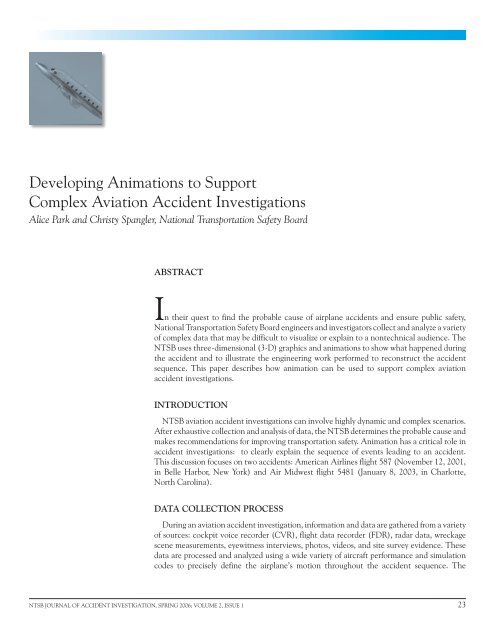Journal of Accident Investigation
Journal of Accident Investigation
Journal of Accident Investigation
You also want an ePaper? Increase the reach of your titles
YUMPU automatically turns print PDFs into web optimized ePapers that Google loves.
Developing Animations to Support<br />
Complex Aviation <strong>Accident</strong> <strong>Investigation</strong>s<br />
Alice Park and Christy Spangler, National Transportation Safety Board<br />
ABSTRACT<br />
I n their quest to find the probable cause <strong>of</strong> airplane accidents and ensure public safety,<br />
National Transportation Safety Board engineers and investigators collect and analyze a variety<br />
<strong>of</strong> complex data that may be difficult to visualize or explain to a nontechnical audience. The<br />
NTSB uses three-dimensional (3-D) graphics and animations to show what happened during<br />
the accident and to illustrate the engineering work performed to reconstruct the accident<br />
sequence. This paper describes how animation can be used to support complex aviation<br />
accident investigations.<br />
INTRODUCTION<br />
NTSB aviation accident investigations can involve highly dynamic and complex scenarios.<br />
After exhaustive collection and analysis <strong>of</strong> data, the NTSB determines the probable cause and<br />
makes recommendations for improving transportation safety. Animation has a critical role in<br />
accident investigations: to clearly explain the sequence <strong>of</strong> events leading to an accident.<br />
This discussion focuses on two accidents: American Airlines flight 87 (November 12, 2001,<br />
in Belle Harbor, New York) and Air Midwest flight 481 (January 8, 2003, in Charlotte,<br />
North Carolina).<br />
DATA COLLECTION PROCESS<br />
During an aviation accident investigation, information and data are gathered from a variety<br />
<strong>of</strong> sources: cockpit voice recorder (CVR), flight data recorder (FDR), radar data, wreckage<br />
scene measurements, eyewitness interviews, photos, videos, and site survey evidence. These<br />
data are processed and analyzed using a wide variety <strong>of</strong> aircraft performance and simulation<br />
codes to precisely define the airplane’s motion throughout the accident sequence. The<br />
NTSB JOURNAL OF ACCIDENT INVESTIGATION, SPRING 2006; VOLUME 2, ISSUE 1 23
















